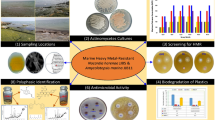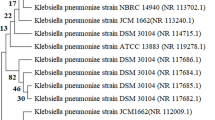Abstract
Delta-aminolevulinate dehydratase (ALAD) activity has been used in prokaryotes and eukaryotes as a biomarker for environmental lead (Pb) exposure and toxicity. Microorganisms are sensitive indicators of toxicity at the fundamental level of ecological organization, but bacterial biomarker studies are focused on the Pseudomonas strains in Group I and E coli. The objectives of the present work were to determine if Burkholderia gladioli belonging to group II, due to its 16SrRNA similarity, can be used as biomarker in metal contamination and compare its possible usage with Pseudomonas aeruginosa and Citrobacter freundii (previously known as Esherichia freundii) and Bacterium freundii which are classified in Group I. In this study, ALAD activity in an environmental strains of Burkholderia gladioli, Pseudomonas aeruginosa, Citrobacter freundii were investigated to evaluate potential inhibition by Pb and other toxic metals. When the ALAD activity of Burkholderia gladioli was tested, Co and Pb decreased activity by 27 and 71%, respectively. In addition to these findings, Zn increased the activity up to 26%. These effects were found to be statistically meaningful (p < 0.05). It was determined that the increase of lead concentration inhibites the ALAD activity at each of the three strains. There was a statistically significant dose–response relationship between ALAD activity in cells of Burkholderia gladioli and Pb (Pearson correlation coefficent = −0.665; r 2 = 0.665, and p < 0.001). The strongest ALAD inhibition which was measured was 90% at Burkholderia gladioli when protein extracts were incubated with 750 μM of Pb. The relationship between Pb and ALAD activity was statistically described by [ALAD Activity] = 0.476−0.000597 × [Pb]. According to the obtained results, we suggest that the ALAD of Burkholderia gladioli can be used as a biomarker for lead contamination in the environment.
Similar content being viewed by others
References
Aisemberg, J., Nahabedian, D. E., Wider, E. A., & Guerrero, N. R. V. (2005). Comparative study on two freshwater invertebrates for monitoring environmental lead exposure. Toxicology, 210, 45–53.
Battistuzi, G., Petrucci, R., Silvagni, L., Urbani, F. R., & Caiola, S. (1981). δ aminolevulinate dehydratase: A new genetic polymorphism in man. Annals of Human Genetics, 45, 223–229.
Boulay, J. P. D., Richard, N. S., Gordon, C. L., & Webber, C. E. (1998). Effect of the delta-aminolevulinate dehydratase polymorphism on the accumulation of lead in bone and blood in lead smelter workers. Environmental Research, 77, 49–61.
Bradford, M. M. (1976). A refined and sensitive method for the quantitation of microgram quantities of protein utilizing the principle of protein-dye binding. Analytic Biochemistry, 72, 248.
Brisse, S., Stefani, S., Verhoef, J., Belkum, A. V., Vandamme, P., & Goessens, W. (2002). Comparative evaluation of the BD Phoenix and VITEK 2 automated instruments for identification of isolates of the Burkholderia cepacia complex. Journal of Clinical Microbiology, 40, 1743–1748.
Conner, E. A., & Fowler, B. A. (1994). Biochemical and immunological properties of hepatic δ-aminolevulinic acid dehydratase in channel catfish (Ictalurus punctatus). Aquatic Toxicology, 28, 37–52.
David, R., Bodlaender, B. P., & Shemin, D. (1980). Mechanism of porphobilinogen synthase. The Journal of Biological Chemistry, 255, 2030–2035.
Deguchi, J., Tamura, M., & Yamazaki, I. (1985). Photoooxidation of porphyrin in MG-substituted horseradish peroxidase. The Journal of Biological Chemistry, 260, 15542–15546.
Frankenberg, N., Jahn, D., & Jaffe, E. (1999). Pseudomonas aeruginosa contains a novel type V porphobilinogen synthase with no required catalytic metal ions. Biochemistry, 38, 13976–13982.
Frere, F., Schubert, W. D., Stauffer, F., Frankenberg, N., Neier, R., Jahn, D., et al. (2002). Structure of Porphobilinogen Synthase from Pseudomonas aeruginosa in complex with 5-Fluorolevulinic acid suggests a double schiff base mechanism. Journal of Molecular Biology, 320, 237–247.
Gilligan, P. H. (1991). Microbiology of airway disease in patients with cystic fibrosis. Clinical Microbiology Reviews, 4, 35–51.
Guerin, W. F., & Boyd, S. A. (1995). Maintenance and induction of naphthalene degradation activity in Pseudomonas putida and an Alcaligenes sp. under different culture conditions. Applied Environmental Microbiology, 61, 4061–4068.
Haigler, B. E., Pettigrew, C. A., & Spain, J. C. (1992). Biodegradation of mixtures of substituted benzenes by Pseudomonas sp. strain JS150. Applied Environmental Microbiology, 58, 2237–2244.
Jaffe, E. K. (2003). An unusual phylogenetic variation in the metal ion binding sites of porphobilinogen synthase. Chemical Biology, 10, 25–34.
Johnsen, K., Andersen, S., & Jacobsen, C. S. (1996). Phenotypic and genotypic characterization of phenanthrene-degrading fluorescent Pseudomonas biovars. Applied Environmental Microbiology, 62, 3818–3825.
Jordan, P. M. (1991). The biosynthesis of 5-aminolevulinic acid and its transformation into uroporphyrinogen III. In A. Neuberger & L. L. N. Van Deenen (Eds.), New comprehensive biochemistry, vol. 19 (pp. 1–65). Amsterdam: Elsevier.
Keel, C., Weller, D. M., Natsch, A., Defago, G., Cook, R. J., & Thomashow, L. S. (1996). Conservation of the 2,4-diacetylphloroglucinol biosynthesis locus among fluorescent Pseudomonas strains from diverse geographic locations. Applied and Environmental Microbiology, 62, 552–563.
Luzzaro, F., Endimiani, A., Tamborini, A., Belloni, R., Lombardi, G., & Toniolo, A. (2001). Evaluation of the phoenix™ automated microbiology system in identification and AST of clinical isolates of Pseudomonas spp.and other nonfermenting gram-negative bacteria. Presented at the 101st General Meeting of the American Society for Microbiology, Orlando, Florida.
Nandi, D. L., & Shemin, D. (1968). Delta-aminolevulinic acid dehydratase of Rhodospeudomonas spheroides II. Association to polymers and dissociation to subunits. Journal of Biological Chemistry, 243, 1231–1235.
Newman, M. C., & Jagoe, C. H. (1994). Ligands and bioavaibility of metals in aquatic environments. In J. L. Hamelink, P. F. Landrum, H. L. Bergman, & W. H. Benson (Eds.), Bioavailability: Physical, chemical, and biological interactions (pp. 39–62). Boca Raton, FL: Lewis.
Nicole, F., Dirk, W. H., & Dieter, J. (1999). Production, purification, and characterization of a Mg2+-responsive porphobilinogen synthase from Pseudomonas aeruginosa. Biochemistry, 38, 13968–13975.
Ogunseitan, O. A. (1998). Protein method for investigating mercuric reductase gene expression in aquatic environments. Applied and Environmental Microbiology, 64,191–204.
Ogunseitan, O. A. (1999). Microbial proteins as biomarkers for ecosystem health. In K. Scow, G. Fogg, D. Hinton, & M. Johnson (Eds.), Integrated assessment of ecosystem healty (pp. 207–222). Boca Raton, FL: Lewis.
Ogunseitan, O. A., Yang, S., & Ericson, J. (2000). Microbial δ-aminolevulinate dehydratase as a biosensor of lead biovailability in contaminated environments. Soil Biology & Biochemistry, 32, 1899–1906.
O’Sullivan, D. J., & O’Gara, F. (1992). Traits of fluorescent Pseudomonas spp. involved in suppression of plant root pathogens. Microbiology and Molecular Biology Reviews, 56, 662–676.
O’Toole, G. A., & Kolter, R. (1998). Flagellar and twitching motility are necessary for Pseudomonas aeruginosa biofilm development. Molecular Microbiology, 30, 295–304.
Palleroni, N. J. (1984). Genus I. Pseudomonas (Migula 1894), vol. 1. (pp. 141–199). In N. R. Krieg & J. G. Holt (Eds.), Bergey’s manual of systematic bacteriology. Baltimore, MD: Williams &Wilkins.
Palleroni, N. J. (1992). Human- and animal-pathogenic pseudomonads. In A. Balows, H. G. Trüper, M. Dworkin, W. Harder, & K.-H. Schleifer (Eds.), The prokaryotes. A handbook on the biology of bacteria: Ecophysiology, isolation, identification, applications (pp. 3086–3103). New York: Springer Verlag.
Palleroni, N. J. (1993). Pseudomonas classification. A new case history in the taxonomy of gram-negative bacteria. Antonie van Leeuwenhoek, 64, 231–251.
Petrovich, R. M., Litwin, S., & Jaffe, E. K. (1996). Bradyrhizobium japonicum porphobilinogen synthase uses two Mg(II) and monovalent cations. Journal of Biological Chemistry, 271, 8692–8699.
Pratt, L. A., & Kolter, R. (1998). Genetic analysis of Escherichia coli biofilm formation: Roles of flagella, motility, chemotaxis and type I pili. Molecular Microbiology, 30, 285–293.
Reynolds, K. D., Schwarz, M. S., McFarland, C. A., McBride, T., Adair, B., Strauss, R. E., et al. (2006). Northern pocket gophers (Thomomys talpoides) as biomonitors of environmental metal contamination. Environmental Toxicology and Chemistry, 25, 458–469.
Rocha, J. B. T., Tuerlinckx, S. M., Schetinger, M. R. C., & Folmer, V. (2004). Effect of group 13 metals on porphobilinogen synthase in vitro. Toxicology and Applied Pharmacology, 200, 169–176.
Sakai, T. (2000). Review article biomarkers of lead exposure. Industrial Health, 38, 127–142.
Sommer, S., & Beyersmann, D. (1984). Kinetics of aluminium-induced acid dehydratase. Equilibrium, kinetic, and 113 Cd-nmr-studies. Journal of Inorganic Biochemistry, 20, 131–145.
Tyler, S. D., Strathdee, C. A., Roze, K. R., & Johnson, W. M. (1995). Oligonucleotide primers designed to differentiate pathogenic Pseudomonas on the basis of the sequencing of genes coding for 16S–23S rRNA internal transcribed spacer. Clinical and Diagnostic Laboratory Immunology, 2, 448–453.
Author information
Authors and Affiliations
Corresponding author
Rights and permissions
About this article
Cite this article
Ciğerci, İ.H., Korcan, S.E., Konuk, M. et al. Comparison of ALAD activities of Citrobacter and Pseudomonas strains and their usage as biomarker for Pb contamination. Environ Monit Assess 139, 41–48 (2008). https://doi.org/10.1007/s10661-007-9808-x
Received:
Accepted:
Published:
Issue Date:
DOI: https://doi.org/10.1007/s10661-007-9808-x




